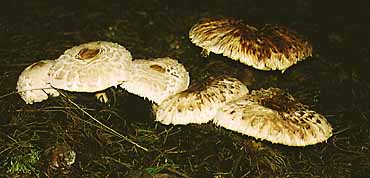

The shaggy parasol is one of the few choice edibles that favors even the difficult growing conditions under eucalyptus and redwoods. The ones pictured above are a bit old. The young, smooth, closed buttons are the best! L. rachodes is a large mushroom that seems to grow just about anywhere. It has white gills, white spores, shaggy fibrous scales on its cap, and an easily discernable dull orange staining reaction when cut at the base of the stalk. You can typically find a bulb at the base of the stalk that resembles the volva of an amanita (at least in the variety hortensis that appears frequently on the West Coast); but you will not find any remnants of a universal veil around the bulb, like on the volva of an amanita, even though the scales on the cap of L. rachodes might resemble veil remnants to a casual observer. You should also make careful note of the spore color. If the spores are greenish, don't eat it! The poisonous green-spored Chlorophyllum molybdites looks strikingly similar to L. rachodes and sometimes even stains dull orange. Apparently, the C. molybdites prefers warm weather and lawns, whereas L. rachodes prefers cool rains and woodland environments, but always be cautious when collecting this mushroom.
My fondness for this mushroom has increased over the years. It has a firm agaric-like texture and a light but rich nutty flavor. The young caps are large enough and firm enough for stuffing, and the older caps dry well and make an excellent broth. Best of all, once you find a fairy-ring of L. rachodes you can return to it throughout the rainy season for a fairly reliable harvest, all the way into Springtime.
Here are some dishes using the shaggy parasol: